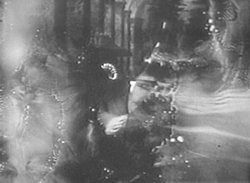
Still from Morrison: Decasia
Film As Art
Bill Morrison’s film Decasia: The State of Decay is art. I don’t mean to say that Hitchcock’s Vertigo or any number of Dogma films are any less art. But Decasia is art the way Blood of a Poet is or Stan Brakhage’s Mothlight or Bruce Conner’s Movie or Andy Warhol’s Empire are.
Decasia was originally created for a multimedia event, featuring the music of Bang-on-a-Can founder Michael Gordon at the Bridge Theater, then performed as a music-with-film piece for the Basel Sinfonietta.Although Gordon’s music is fine by itself (and is also about decay), the original cart is leading the horse, for the film has a life of its own outsideits multimedia roots.
The sequences seem to be cut to the music, which now forms the soundtrack. But there was probably a good deal of back-and-forth between the filmmaker and composer.The music might be able to stand on its own, but I tried watching the DVD without the soundtrack. It’s not quite the same, so I suspect that sound and image are integral.

Briefly, the viewer is led from a whirling dervish through various sequences of beauteous decay: nuns and children in cloisters, rescues, parts of a 1912 Pearl White film, an invasion. Then an hour or so later we are back to the dervish. In the interim there are gorgeous blooms, blobs, and even black-and-white inversions looking strangely like solarization. A boxer battles a “living” punching bag, ghosts dance, and ectoplasm seems to invade a heated drawing-room scene.
But the moving, amoebic, moldy blobs and blisters are the best. It is as if the flesh of vision is being devoured, all to the music of brake drums and eerie, out-of-tune pianos. And as a friend of mine volunteered, Decasia is a kind of time machine. Developing this idea, it is not so much that nitrate film stock is unstable, but that memory is.
Decasia fits into the category of a now largely ignored tradition: that of films meant to hold their own with painting and sculpture. Not, of course, as paintings and sculptures per se, but as films made outside the mass-media market and usually outside the narrative tradition, and within the modernist and postmodernist visual-art playing field.
Often, as modernists would have it, these so-called experimental movies are films-about-film — as, in part, Decasia is. But that is only half the story. The other half is that they evince personal expression of a kind that Hollywood (or Bollywood, for that matter) can rarely afford, because of the group structure of the enterprise and the audience target. The New American Independent Cinema (too much of a mouthful to function as an effective tag, if you ask me), sometimes called Underground Cinema (better, but sounds more subversive than warranted), in full flame from the ’40s through the ’60s, was probably one of those glory moments that cannot be duplicated.
This is not to say that “underground films” (more likely these days to be digital-format video) are no longer made. As long as verbal language exists, somewhere a poet will be making a poem. So too, as long as there’s an affordable way to capture and string together moving images, there will be an artist-filmmaker, videoist, or digitalist playing with, or even against, images in time. It’s just that the discussion about avant-garde film like all discourse, had a half-life and has itself decayed.
The repressed topic, the subject that should be addressed, is this loss. Decasia is so good a film it should renew that discourse. This is the real importance of Decasia and not the journalistic emphasis on, say, the tragedy of disintegrating nitrate and the need to save so many films in so little time.
Painters and sculptors and even art critics used to attend screenings of new avant-garde, experimental films and argue about them. Independent art films were part of the art culture, as was music (John Cage speaking at The Club,John Coltrane playing at the Five Spot and the Cedar Bar) as was dance (Merce Cunningham). Many artists, I would guess, fantasized about making films. Some, like Red Grooms, made amusing films and some, like Alfred Leslie, made important ones (Pull My Daisy) that encapsulate the feel of an artistic milieu.
Now, when painters want to make movies, they want to make Hollywood films. This is okay if you are Julian Schnabel and actually have some mass-media talent, but otherwise, leaving aside the beautiful and moving wall projections of Shirin Neshat and the iffy epics of Matthew Barney, we can only mourn that film as art has been subsumed by film as entertainment .
Decasia, coming through the front door, as it were, of the popular press, may be the sign of change. A laudatory article by Lawrence Weschler (author of books on artist Robert Irwin and the playful Museum of Jurassic Technology in L.A.) in the New York Times Sunday Magazine in December 2002 was not really the kiss of death it could have been. Remember that Jackson Pollock’s first big splash was in Vogue.
Decasia is imbedded in the film-as-art tradition; if you are conversant with that world you cannot look at it without thinking of Stan Brakhage’s various scratched and painted films and, for the use of found footage, Joseph Cornell’s sublime Rose Hobart. Yet,as it should be, Morrison’s masterpiece is curiously new. It has been shown at various film venues all over the world, on the Sundance cable channel, at MoMA, recently projected on the wall of the Maya Stendhal Gallery in Chelsea (along with some new, but shorter, works), and is now available for purchase or rental in aDVDformat.
* * *
Also available on DVD, as of late last year, is By Brakhage, An Anthology, a two-disk set (the Criterion Collection) that includes 25 of that seminal filmmaker’s efforts. Stan Brakhage (1933-2003), beginning with his “epic” Dog Star Man (1961-64), used patches of willfully scratched and altered emulsions and then, after a certain point, hand-painted frames almost exclusively.
When I first saw Decasia, I thought I’d better look at Brakhage again. Morrison studied animation, but his film is more like films in the experimental tradition than Fantasia. So I suffered once more through Window Water Baby Moving (1959). An actual childbirth! The father present! It is instead the restless camera and the off-kilter framing, the superimpositions and speed-shots that make it still worth seeing.
Dog Star Man (Brakhage and his family alone in the Colorado mountains) has its moments too, but whatever you do skip the Brakhage interview on the disk. It will ruin Dog Star Man forever. The tree he is seen chopping is supposed to be the Nordic tree of life. Sorry, Stan, the stories you told yourself are not the story this film tells.
Brakhage seemed determined to indulge in beatnik twaddle. Let’s just say it was the times that made him do it. Defense of even semiabstraction and of ruptured narrative had to take the form of smarmy mythmaking. I much prefer this quote from his book Metaphors on Vision:
Imagine an eye unruled by man-made laws of perspective, an eye unprejudiced by compositional logic, an eye which does not respond to the name of everything but which must know each object encountered in life through an adventure of perception.
The truth is that as Brakhage moved from antinarrative structuring of buried narratives and the quasi-documentary to total abstraction, he got better and better. The three-minute Mothlight of 1963 is the real breakthrough film, a kind of waltz of moth wings. From then on, it is an endless string of brilliant films. However, he couldn’t break from fancied story-telling or beat generation gestures towards poetry. Like all good DVDs, By Brakhage has “extras,” in this case the filmmaker talking about his work. Approach with caution. Don’t listen to what he thought he was doing when he made The Dante Quartet (1987).
Forget Dante, just look at the film. It’s made up of handpainted frames that obliterate the underling photographic images. It’s like seeing a thousand and one abstract expressionist paintings, pixilated. Of course, with a DVD you can stop the action and see it frame by frame. The individual images are most often held for two or three frames. Thereby, surprisingly, it is revealed that in fact the individual handpainted frames would really not make great paintings. What is important — surprise! — is how they move from one to the next, in a great balance between single image and persistence of vision. The latter of course is the trick of movies that makes the images seem to move.
For discussion further along the road:
Is there an appreciable aesthetic difference between moving pictures projected floor-to-ceiling on gallery or museum walls and those projected in movie theaters, on a screen with everyone sitting face-forward, eating popcorn? Is there a difference between either of these and watching a movie at home on a video monitor? Would new art star Douglas Gordon’s brilliant, super slow-motion24-Hour Psycho or his superimposition of The Song of Bernadette and The Exorcist work on your TV? Is the future of “underground cinema” (i.e., the art movie) the DVD? Will the DVD and the download future revive or further undermine the underground? If the “underground film” has been absorbed by the art world’s embrace of projected installations, how do we explain the above-ground distribution of Gus Van Sant’s Psycho and Gerry and Mike Figgis’ four-screen, real-time Timecode? Or even Christopher Nolan’s backwards narrative Momento? Can there be a new post-post-Structuralist , post-Deconstructionist view of cinema that includes more “experimental” films as well as mass-market ones? Can we put the baby back in the bath?
